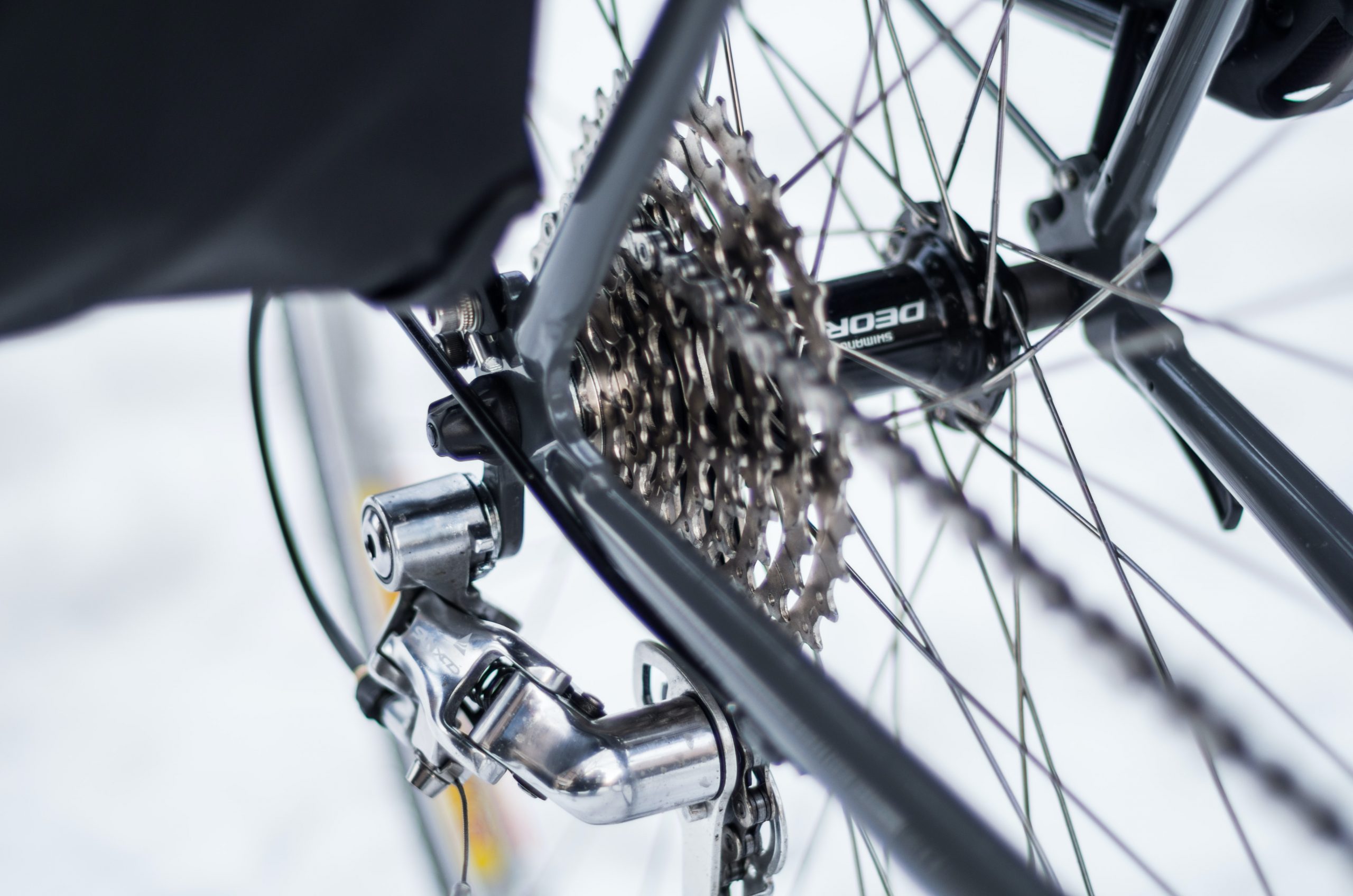When you think about the component of your bike that needs the most attention, your mind goes to your tires. Aside from your tires, your bike’s chain is perhaps the element that wears off quickly and needs to be replaced the most.
Adequate maintenance of your bike chains increases the quality of your shifting and prolongs the life of the rest of your drivetrain components.
When Is the Time to Replace Your Bike Chain?

Internal bushings in each link of your chain gradually lengthen as it ages. As a result, your longer chain puts more strain on your cassette cogs and chainring teeth, leading them to wear down more quickly. This also impacts the shifting quality.
It is a common rule to change your bike’s chain every 2,000 miles to minimize the rushed wear of your cassette and chainrings. However, this doesn’t apply to every bike chain. No riders treat their bike chains the same way; therefore, different chains will wear at different rates.
How to check for chain wear
It’s vital to remember that chains rarely wear evenly, all the way down. As a result, whichever method you use to assess chain wear, make sure to do it in three to five portions and select the highest measurement. Also, don’t include the quick link or any similar joining link in your assessment because these have a slower wear rate.
The first way of checking for chain wear is effortless and free of charge. All you have to do is pull the chain at the front of the chainring after shifting gears so that your chain is in the big ring and the smallest gear on the cassette. The chain has started to wear or is worn if it starts to lift off the top or bottom of where it lies, on the chainring teeth. However, this technique can offer a wrong interpretation if the chainring is worn out since even a new chain on a worn-out chainring will cause identical lifting.
In addition, you can use a regular ruler to measure chain wear. To do so, you’ll need to know that modern chains have half-inch pins and that you’ll be measuring from one pin to another 12 inches apart. Begin by tensing the chain. Align the zero-inch mark of the ruler with the center of a pin, then check where the ruler’s 12-inch mark lines up. The chain is in excellent shape if it is dead center on a pin. If the pin is below 1/16 of an inch before the 12-inch line, the chain is worn but still has a long life ahead of it. It will be time to replace your bike chain if the pin is more than 1/16 of an inch ahead of the 12-inch line.
Because of the variances in riding styles, it’s best to regularly check your chain’s condition with a chain wear measuring tool. All you need is a basic fixed-length, drop-in style tool to get a quick go/no-go gauge on your chain wear. The .5% marker on most chain wear checkers indicates a recommended replacement point for 11 and 12-speed drivetrains or a warning for 10-speed or lower systems. For 10-speed and lower, a replacement of .75% is recommended. Some tools also have a 1% wear point, which is best kept for 8-speed chains and lower. For your safety, we recommend replacing a chain at the .5 marking. This percentage applies to 10, 11, and 12-speed setups bikes.
How to Replace Your Bike Chain
A bike chain is an essential component of your bicycle, serving to transfer power from the pedals to the rear wheel. Over time, a bike chain can stretch and wear out, affecting the performance and efficiency of your ride. Replacing a bike chain is a relatively straightforward process that can be done with just a few tools. In this guide, we will walk you through the steps to replace your bike chain and get back on the road in no time. Whether you’re a seasoned cyclist or a beginner, this guide will help you get the job done quickly and easily.
Remove the old chain and clean the cassette
First, you need to get rid of the old chain. You can separate the chain by compressing the quick link (a two-piece link that you can push together to unfasten it). To split the chain, you’ll need to use a chain tool to force out one pin. Place the links between the tool’s teeth and twist it until the pin pops out.
Now, it is the ideal time to clean and inspect your chainrings and cassette. Make sure that all of the teeth have symmetrical profiles. As the chain bites into them, they take on the shape of a shark’s teeth. If everything appears to be in good working order, clean both using a cleaning solution since there’s no point placing a clean chain onto filthy cogs!
Determine the new chain length
At this point, you will need to cut your new chain down to length. Pull the ends of the chain around the smallest sprocket and chainring to meet underneath your bike’s chainstay.
It is recommended that the open end faces backward. Now that you’ve identified the link that needs to be severed, it’s time to grab the chain tool once more. Place the link you want to work on between the tool’s jaws. Turn the knob until the pin begins to push the link’s center. To avoid damaging the equipment, make sure everything is aligned.
Install the new chain
Now it is time to install the new chain. Locate the pointed end of the joining pin that came with your new chain. Connect the chain’s ends by slotting them together. Push the pin into the chain, facing the bike from the drive side, to keep it together. It should stay in place without your assistance.
Pick up the chain tool once more and unscrew the handle a few times. Insert the chain tool into the link held together by the pin. Screw the handle down to secure the pin. Turning the handle will become easier as the pin becomes almost flush with the outer plate of the link. Slowly work your way around the plate until the pin’s end is flush with the outside of the plate. Remove the chain tool after it’s in place.
Finally, check to see if the link you’ve joined is still moving freely. If it doesn’t, and the pin sticks out more than the other ones in the chain, try reattaching the chain tool by giving it a gentle push. If the chain appears to be in the proper position, try flexing it horizontally to free it up. When you’re satisfied, snap the end of the pin off by giving it a sharp twist with the back of the tool or pliers, and you’ll be good to go!
How to Fix a Chain on the Go

There are times when you can face problems with your bike chain, even when you’re out biking and don’t have the proper tools to fix or change your chain. If your chain breaks in the middle of a ride, use the chain breaker on your multitool to replace the broken link. If you don’t have any extra chain link pins, you can reattach the chain with an existing pin. Because the mushroomed end of the pin becomes rounded off when removed, don’t drive it entirely out; instead, leave it on one side plate. In such conditions, the chain will be shorter, and the connection will be weak, so ride home carefully and replace the damaged chain before your next trip.
How to Maintain a Bike Chain
Chain maintenance hugely impacts your chain’s lifespan. Properly cleaning your bike chain will have an impact on the overall security while you’re riding.
However, cleaning your bike chain tends to be messy, so we recommend putting on some gloves and starting with the first step.
- Start by degreasing your chain. If you have a tool designated for chain cleaning, fill the tool with your bike-specific degreaser and wrap it around your chain. Then backpedal with your free hand. Your chain cleaner’s brushes will clean all of the nooks and crannies while also collecting degreaser in the reservoir.
- However, if you don’t have the designated tool, degrease your chain with a brush. You can do it with a toothbrush or a nail brush. Degrease the brush and hold it to the top of your chain while you backpedal. Make sure to repeat this step with the bottom of your chain, brushing the part of the chain beneath your drivetrain each time.
- To remove the extra degreaser, clean your chain with soapy water and rinse. Then pick your lube. If you’re riding in wet, muddy terrain, use wet lube; if you’re riding in a dry environment, use dry lube. Apply a small amount of lube to the top of each roller in your chain. Make sure to put the lube directly at your rollers. Placing lube on the outside of the chain collects more dirt.
- Finally, wipe off any excess lube, and you’re ready to go!
The Bottom Line
Replacing bike chains is a quick and easy process, and it requires just a few minutes of your time and some simple tools. However, knowing how to change bike chains can come in handy in situations when you’re on the road all by yourself. Proper bike chain installation will allow you to enjoy your bike rides without having to worry about your safety.




